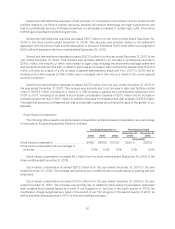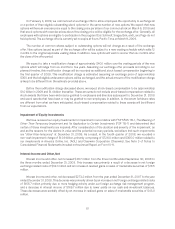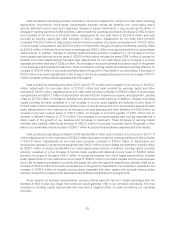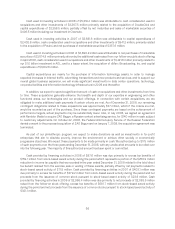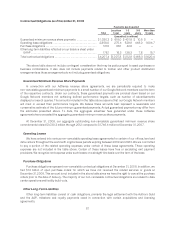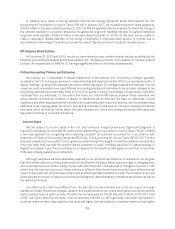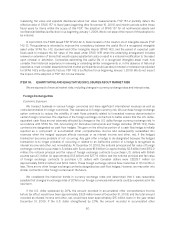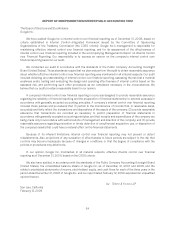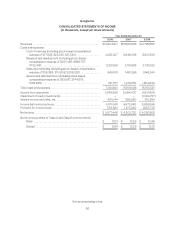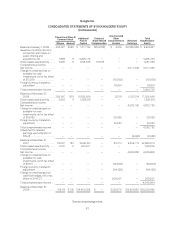Google 2008 Annual Report Download - page 74
Download and view the complete annual report
Please find page 74 of the 2008 Google annual report below. You can navigate through the pages in the report by either clicking on the pages listed below, or by using the keyword search tool below to find specific information within the annual report.In addition, as a result of having adopted Financial Accounting Standards Board Interpretation No. 48,
Accounting for Uncertainty in Income Taxes (FIN 48) in January 2007, we increased long-term taxes payable by
$400.4 million in the year ended December 31, 2007 as FIN 48 specifies that tax positions for which the timing of
the ultimate resolution is uncertain should be recognized as long-term liabilities. We also recognized additional
long-term taxes payable of $362.8 million in the year ended December 31, 2008. At this time, we are unable to
make a reasonably reliable estimate of the timing of payments in individual years beyond 12 months due to
uncertainties in the timing of tax audit outcomes. As a result, this amount is not included in the table above.
Off-Balance Sheet Entities
At December 31, 2007 and 2008, we did not have interests in any variable interest entities, as defined by the
Financial Accounting Standards Board Interpretation No. 46 (Revised 2003), Consolidation of Variable Interest
Entities—An Interpretation of ARB No. 51, having a significant effect on the financial statements.
Critical Accounting Policies and Estimates
We prepare our Consolidated Financial Statements in accordance with accounting principles generally
accepted in the U.S. In doing so, we have to make estimates and assumptions that affect our reported amounts of
assets, liabilities, revenues and expenses, as well as related disclosure of contingent assets and liabilities. In some
cases, we could reasonably have used different accounting policies and estimates. In some cases, changes in the
accounting estimates are reasonably likely to occur from period to period. Accordingly, actual results could differ
materially from our estimates. To the extent that there are material differences between these estimates and
actual results, our financial condition or results of operations will be affected. We base our estimates on past
experience and other assumptions that we believe are reasonable under the circumstances, and we evaluate these
estimates on an ongoing basis. We refer to accounting estimates of this type as critical accounting policies and
estimates, which we discuss further below. We have reviewed our critical accounting policies and estimates with
the audit committee of our board of directors.
Income Taxes
We are subject to income taxes in the U.S. and numerous foreign jurisdictions. Significant judgment is
required in evaluating our uncertain tax positions and determining our provision for income taxes. FIN 48 contains
a two-step approach to recognizing and measuring uncertain tax positions accounted for in accordance with
Statement of Financial Accounting Standards (SFAS) No. 109, Accounting for Income Taxes (SFAS 109). The first
step is to evaluate the tax position for recognition by determining if the weight of available evidence indicates that
it is more likely than not that the position will be sustained on audit, including resolution of related appeals or
litigation processes, if any. The second step is to measure the tax benefit as the largest amount that is more than
50% likely of being realized upon settlement.
Although we believe we have adequately reserved for our uncertain tax positions, no assurance can be given
that the final tax outcome of these matters will not be different. We adjust these reserves in light of changing facts
and circumstances, such as the closing of a tax audit, the refinement of an estimate or changes in tax laws. To the
extent that the final tax outcome of these matters is different than the amounts recorded, such differences will
impact the provision for income taxes in the period in which such determination is made. The provision for income
taxes includes the impact of reserve provisions and changes to reserves that are considered appropriate, as well as
the related net interest.
Our effective tax rates have differed from the statutory tax rate primarily due to the tax impact of foreign
operations, certain impairment charges, research and experimentation tax credits, state taxes, and certain benefits
realized related to stock option activity. The effective tax rates were 23.3%, 25.9% and 27.8% for 2006, 2007 and
2008. Our future effective tax rates could be adversely affected by earnings being lower than anticipated in
countries where we have lower statutory tax rates and higher than anticipated in countries where we have higher
58




